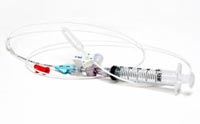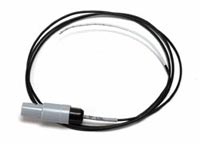Cardiac Catheterization
The cardiac catheterization laboratory is where doctors can diagnose and treat heart conditions using catheters instead of surgery.
Many different procedures can be safely done in the lab instead of an operating room.
What are catheters?
Catheters are spaghetti-like plastic tubes used to insert special tools to diagnose or treat a heart problem.
There are many sizes and shapes of catheters so heart doctors (cardiologists) can perform many different procedures.
Rather than a large cut (incision) on the chest from open-heart surgery, children having cardiac catheterization need only a tiny cut where doctors put in the catheter.

A catheter used in balloon procedures, such as to open a narrow blood vessel or heart valve.

A catheter used in electrophysiology (EP) studies to check for heart rhythm problems.
Why are catheters used?
There are 2 main reasons catheters are used: for diagnostic procedures and for treatments.
For diagnosis, doctors may use catheters to measure pressure in the heart or to insert special dyes so they can take pictures of the inside of the heart (called angiography).
These procedures help doctors plan your child’s care by showing details that an electrocardiogram (ECG or EKG) or echocardiogram may not be able to.
Often, catheters are used to treat common heart defects. This use is called interventional or therapeutic catheterization.
Catheters may be used to open narrow blood vessels and heart valves, close holes in the wall (septum) between heart chambers and close abnormal blood vessels.
Doctors also use specialized catheters to study and treat heart rhythm problems (electrophysiology procedures). Catheters also can be used to treat some types of arrhythmia through radiofrequency ablation or cryoablation.
When do we arrive for the appointment?
The day before a catheterization procedure, a Seattle Children’s staff member will call to tell you what time to arrive at the hospital.
Also, we will give you details about feeding your child, including a specific time to stop giving them anything to eat or drink. It is important that they have an empty stomach before their procedure. This is done to keep them safe from food or liquid getting into their lungs while they are asleep (under anesthesia).
Where do we go for the appointment?
Please check in for cardiac catheterization procedures at the Surgery Center on level 6 of the hospital. (Directions to the hospital.)
What happens before the cardiac catheterization procedure?
Many things need to happen before the procedure to make it as safe as possible. We will ask general health questions, do a brief physical exam of your child and check your child’s weight and height.
You will meet many people involved in caring for your child before and during the catheterization:
- A cardiac anesthesiologist will meet you and talk about how we will keep your child comfortable during the procedure. The anesthesiologist will be in charge of getting your child to sleep and keeping them from feeling any pain during the procedure.
- You also will meet the doctor who will do the procedure and insert your child's catheter. The doctor and a nurse practitioner will explain the procedure and its risks and benefits before the procedure starts.
Next, you and your child will be brought into the induction area, where your child will be given a mild sedative. Then your child will be brought into the catheterization laboratory.
You may be asked if you want to come into the catheterization lab to be with your child as they fall asleep.
You will be given a pager so you can be paged with updates and notified when the procedure is over.
What happens during the procedure?
After your child is asleep, the cardiologist starts the catheterization.
Most of the time, the doctor makes a small hole (puncture) with a needle at the top of the leg to insert the catheter into a blood vessel. Sometimes other blood vessels are used, including one on the neck.
The doctor places a needle in the vein or artery and then replaces the needle with a plastic tube called a sheath. The sheath lets the doctor put the catheter in safely and prevents bleeding from the needle puncture.
From there, the doctor can advance the catheter into the chambers of the heart. For some procedures, your child may have more than one catheter.
We give you a pager to carry during the catheterization, which means you can wait anywhere in the hospital that is comfortable for you. A nice place to wait is the Family Resource Center on level 7 in the River zone.
How long does it take?
Most catheter procedures take at least 2 hours.
Electrophysiology procedures can last 5 hours or more.
What happens after the procedure?
With the procedure done, the doctor removes all the catheters. A large bandage is placed over the small entry holes.
Your child must lie flat and still and keep their leg straight for 4 hours after the procedure. Your child will spend the first hour in the main recovery room waking up from the anesthesia.
Usually, after a diagnostic procedure children go home the same day. After a treatment, or intervention, children often stay overnight. We will tell you in advance what to expect in your child’s case.
If your child is expected to go home that day, they will spend 3 to 4 hours in another recovery room where you can be at their side. Your child can watch television or movies, play video games, eat, read and relax, but they must remain flat and still and keep their leg straight.
If your child is expected to stay in the hospital, the doctor will talk with you about what to expect, including when you can be with your child after the procedure.
Before you go home, we will tell you about signs to look for that may mean your child should return to the hospital. A nurse will explain the discharge instructions in detail, including when your child can be active again.
When can my child go home?
In most cases, children can go home after spending 4 to 5 hours in recovery. Your child may be admitted to our hospital to spend the night.
Often, children can go back to normal activities within several days.
Read more about care of your child after a cardiac catheterization or electrophysiology study (PDF) (Russian) (Spanish) (Vietnamese).
Contact Us
Contact the Heart Center at 206-987-2015 for a referral, a second opinion or more information.
Providers, see how to refer a patient.
Telemedicine at Seattle Children’s
You may be offered a telehealth (virtual) appointment. Learn more.
Paying for Care
Learn about paying for care at Seattle Children’s, including insurance coverage, billing and financial assistance.